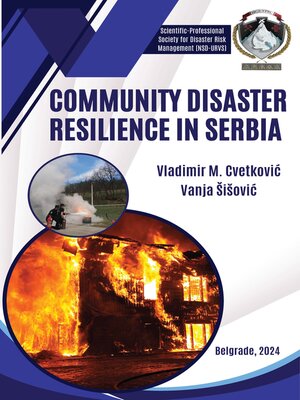
Sign up to save your library
With an OverDrive account, you can save your favorite libraries for at-a-glance information about availability. Find out more about OverDrive accounts.
Find this title in Libby, the library reading app by OverDrive.



Search for a digital library with this title
Title found at these libraries:
| Library Name | Distance |
|---|---|
| Loading... |
In the face of natural disasters, communities are often the first line of defence, bearing the brunt of devastation while also displaying remarkable resilience in their aftermath. The ability of societies to withstand, adapt to, and recover from such crises is a testament to the strength and resourcefulness inherent in human communities. This monograph, titled "Community Disaster Resilience in Serbia," represents a concerted effort to delve into the underlying dynamics that shape a community's capacity to cope with natural disasters. Focusing on Serbia, a country with a rich tapestry of social, economic, and demographic complexities, this research endeavors to unravel the intricate interplay between various socio-economic and demographic factors and community resilience. The research methodology employed in this study is grounded in a comprehensive quantitative approach, leveraging rigorous statistical analyses to explore the multifaceted dimensions of community disaster resilience. At its core, this study recognizes the critical importance of understanding how factors such as income, employment status, marital status, education, risk perception, gender, and age intersect to influence a community's ability to withstand and recover from natural disasters. By shedding light on these nuanced relationships, we aim to equip policymakers, practitioners, and community leaders with evidence-based insights to enhance disaster preparedness and response efforts. A notable aspect of our methodology is the utilization of the snowball sampling method, which facilitated the organic expansion of our participant pool. By harnessing the networks and connections within communities, we were able to access a diverse array of voices, enriching our dataset and ensuring the robustness of our findings. Central to our inquiry is the exploration of how age, education, and gender intersect with broader social structures, capital, mechanisms, equity, diversity, and beliefs to shape community disaster resilience in Serbia. By elucidating these relationships, we aim to provide insights that can inform targeted interventions and policy initiatives aimed at bolstering community resilience across the country. This monograph holds significant importance in the field of disaster resilience research and practice for several reasons. Firstly, it fills a crucial gap in the existing literature by providing comprehensive insights into the impacts of demographic and socioeconomic factors on community disaster resilience, particularly within the context of Serbia. While studies on disaster resilience abound, there is a notable scarcity of research specifically examining the influence of demographic and socioeconomic factors on resilience in this region. Secondly, the findings of this research offer practical implications for policymakers, government agencies, non-governmental organisations, and community leaders involved in disaster management and resilience-building initiatives. By identifying key predictors and factors influencing community resilience, stakeholders can tailor interventions and strategies to address specific vulnerabilities and enhance the capacity of communities to withstand, adapt to, and recover from disasters effectively. Furthermore, the utilization of robust statistical methods and the comprehensive nature of the research design enhance the reliability and validity of the findings presented in this monograph. The employment of multivariate regression analysis allows for a nuanced understanding of the relationships between various predictors and different dimensions of community disaster resilience, providing valuable insights for both academics and practitioners.







